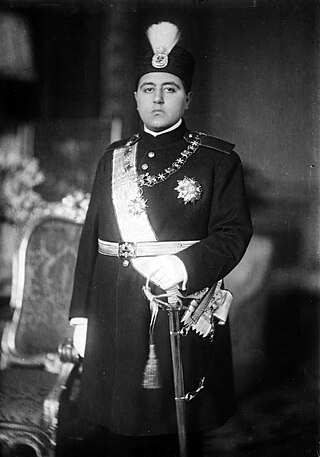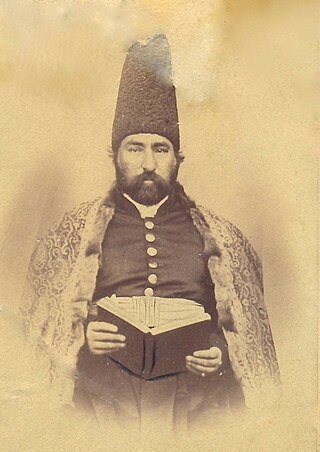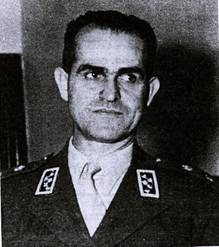
The Qajar dynasty was an Iranian royal dynasty founded by Mohammad Khan of the Qoyunlu clan of the Turkoman Qajar tribe.

Ahmad Shah Qajar was the shah of Iran (Persia) from 16 July 1909 to 15 December 1925, and the last ruling member of the Qajar dynasty.

Fath-Ali Shah Qajar was the second Shah of Qajar Iran. He reigned from 17 June 1797 until his death on 24 October 1834. His reign saw the irrevocable ceding of Iran's northern territories in the Caucasus, comprising what is nowadays Georgia, Dagestan, Azerbaijan, and Armenia, to the Russian Empire following the Russo-Persian Wars of 1804–1813 and 1826–1828 and the resulting treaties of Gulistan and Turkmenchay. These two treaties are closely tied to Fath-Ali Shah's legacy amongst Iranians, who often view him as a weak ruler.

Mozaffar ad-Din Shah Qajar was the fifth Qajar shah of Iran, reigning from 1896 until his death in 1907. He is often credited with the creation of the Persian Constitution of 1906, which he approved of in one of his final acts as shah.

Naser al-Din Shah Qajar was the fourth Shah of Qajar Iran from 5 September 1848 to 1 May 1896 when he was assassinated. He was the son of Mohammad Shah Qajar and Malek Jahan Khanom and the third longest reigning monarch in Iranian history after Shapur II of the Sassanid dynasty and Tahmasp I of the Safavid dynasty. Naser al-Din Shah had sovereign power for close to 51 years.
Prince Abbas Mirza Farman Farmaian Qajar (1890–1935) was an Iranian prince of the Qajar dynasty, the second son of Prince Abdol-Hossein Mirza Farmanfarma of Persia, one of the most preeminent political figures of his time and of the royal Princess Ezzat ed-Dowleh Qajar, the daughter of king Mozaffar-al-Din Shah. He was named after his great-grandfather, crown prince Abbas Mirza, the son of Fath Ali Shah Qajar.

Prince Firouz Nosrat-ed-Dowleh III, GCMG (1889–1937) was the eldest son of Prince Abdol-Hossein Farmanfarma and Princess Ezzat-ed-Dowleh Qajar. He was born in 1889 and died in April 1937. He was the grandson of his namesake, Nosrat Dowleh Firouz Mirza, and of Mozzafar-al-Din Shah Qajar through his mother, Princess Ezzat-Dowleh.
Prince Soltan Ali Mirza Kadjar (Qajar) (Persian: سلطانعلی میرزا قاجار; November 16, 1929 – May 27, 2011) was an Iranian Prince of Qajar dynasty and the son of Soltan Majid Mirza Qajar (1907–1975) and Homadokht Kian (Shayesteh Khanoum) (1912–1992) and the grandson of Mohammad Ali Shah Qajar. He was the Head of the Qajar Imperial Family. Despite Soltan Ali Mirza Qajar being Head of the Qajar Imperial Family, the Qajar claimant to the Sun Throne was the Heir Presumptive Mohammad Hassan Mirza II, son of Soltan Hamid Mirza and grandson of Soltan Ahmad Shah's brother and successor in exile, Mohammad Hassan Mirza Qajar.

Kamran Mirza was a Persian Prince of Qajar dynasty and third surviving son of Nasser al-Din Shah. He was the brother of Mass'oud Mirza Zell-e Soltan and Mozzafar al-Din Shah. Kamran Mirza also served as Iran's Commander-in-Chief, appointed in 1868 for the first time, and minister of war from 1880 to 1896 and from 1906 to 1907.

Bahman Mirza was a Qajar prince, literary scholar, and writer who lived in Iran and later the Russian Empire. The fourth son of the former crown prince Abbas Mirza, his career in Iran was marked by several governorships, including the province of Azerbaijan (1841–1847).

Mahmoud Afshartous, also written Afshartoos, was an Iranian general and chief of police during the government of Prime Minister Mohammad Mossadegh. Afshartous was abducted and killed by anti-Mossadegh conspirators led by MI6 which helped pave the way for the 1953 coup d'état.

Hajji Mohammad Hossein Isfahani (1758–1823) was an architect and political leader in Isfahan under the rule of Fath-Ali Shah Qajar, the second shah of Qajar Iran.
Zarrinnaal or Zarrin Naal is the name of a dynasty of Kurdish tribal chiefs and state officials belonging to the Zarrin Kafsh tribe and originated from Sanandaj in Kurdistan Province of Iran. Their heads with the title of Beyg, Beyk or Beg (lit."lord") were the Aghas of Senneh and ruled their fiefdom during the time of four hundred years when the Safavids, Afsharids and finally Qajar dynasty reigned in Iran.

Malek Jahan Khanom was the wife of Mohammad Shah Qajar and the mother of Naser al-Din Shah. She was the de facto regent of Iran for one month, from 5 September until 5 October in 1848, between the death of her husband and the accession of her son.

Ali Akbar Bahman was an Iranian diplomat and politician during the Qajar and Pahlavi eras.

Amanollah Khan Zia' os-Soltan was an Iranian aristocrat and politician at Qajar court during the time of Mozaffar ad-Din Shah, Mohammad Ali Shah and Ahmad Shah Qajar and hero of the Persian Constitutional Revolution.

Mohammad Taqi Mirza Hessam os-Saltaneh was a Persian Prince of the Qajar dynasty, son of Fath Ali Shah. He was Governor-General (beglerbegi) of Kermanshah and of Boroujerd.

The House of Bahmani, also called Bahmani-Qajar, is an aristocratic Iranian family belonging to one of the princely families of the Qajar dynasty, the ruling house that reigned Iran 1785–1925. The founder is Bahman Mirza Qajar (1810–1884), the younger brother of Mohammad Shah Qajar and formerly prince regent and governor of Azerbaijan 1841–1848.
Mohammad Hassan Khan Sardar Iravani, originally Mohammad Hassan Khan Qajar-Ziyadlu 'Sardar-e Iravan', was a Qajar notable and political figure in 19th century Iran during the reign of Mohammad Shah Qajar and Nasser al-Din Shah Qajar. He passed away on August 30, 1855.

Soltan Mohammad Mirza better known by his honorific title Sayf ol-Dowleh was an Iranian prince of the Qajar dynasty and the thirty-ninth son of Fath-Ali Shah Qajar, the second shah of Qajar Iran. He was the governor of Isfahan between 1820 and 1835 and contributed to its restoration after the damage it suffered during the civil war between the Zand dynasty and Agha Mohammad Khan Qajar, rebuilding several Safavid pavilions and designing his own palace.


















